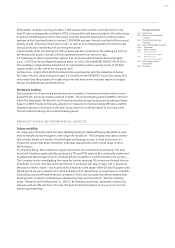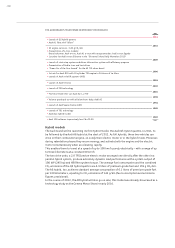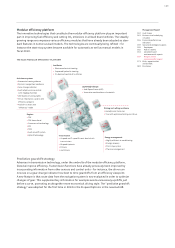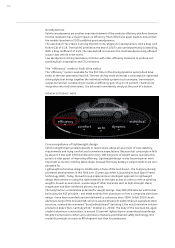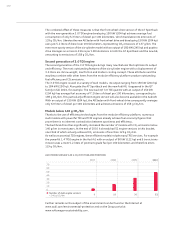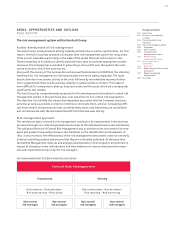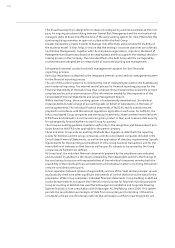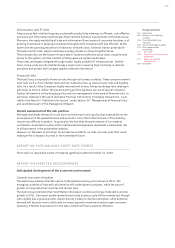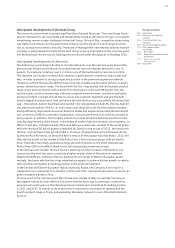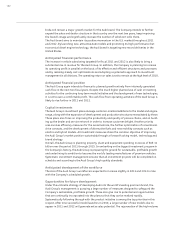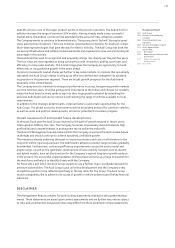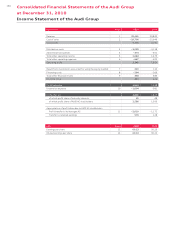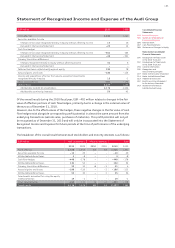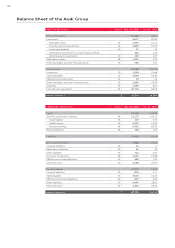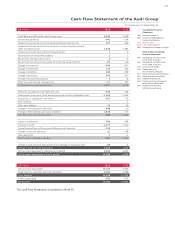Audi 2010 Annual Report Download - page 179
Download and view the complete annual report
Please find page 179 of the 2010 Audi annual report below. You can navigate through the pages in the report by either clicking on the pages listed below, or by using the keyword search tool below to find specific information within the annual report.
177
Management Report
132 Audi Group
141 Business and underlying
situation
156 Financial performance
indicators
159 Social and ecological aspects
173 Risks, opportunities
and outlook
173 Risk report
179 Report on post-balance sheet
date events
179 Report on expected
developments
183 Disclaimer
The generally more difficult conditions in the automotive industry have engendered increased
predatory competition, characterized by the growing use of sales subsidies. This may result in
price erosion and higher marketing costs particularly in the Company’s key sales regions of
Europe, the United States, China and Japan, which would in turn adversely affect its revenue and
earnings performance. Any trend among direct competitors towards reducing prices will likewise
undermine revenue and profit, because the Audi Group will be unable to entirely ignore such
practices in the long term. Moreover, potential state subsidies for individual manufacturers or
vehicle categories could distort competition, thereby having a major adverse effect on the finan-
cial position of the Audi Group.
A further major challenge for the entire automotive industry stems from the growing pressure
to reduce the fuel consumption and emissions of vehicles.
For example, various legal requirements are being discussed and introduced in various parts of
the world, such as CO₂ limits. Furthermore, a protracted public debate could adversely affect the
image of all manufacturers and so ultimately be to the detriment of the Audi Group’s financial
performance. In addition, the heightened sensitivity of customers to environmental acceptabil-
ity and fuel economy means that a permanent shift in the demand profile in individual markets
towards smaller vehicles cannot be excluded.
The Audi Group is prepared to tackle this challenge and not only through the expansion of its
product range to include smaller models like the Audi A1. It has employed a wide range of tech-
nological innovations in the fields of drive technology, lightweight design, aerodynamics and
energy efficiency to improve the fuel economy and CO₂ emissions of the entire vehicle fleet quite
substantially over the past few years. The Company is also intensively researching alternative
fuels and will respond decisively to its customers’ desire for sustainable mobility by developing
advanced hybrid and electric vehicles.
Risks from operating activities
Through its operating activities the Audi Group is exposed to a number of risks that could lastingly
affect its net worth, financial position and financial performance.
These include, most notably, events with serious consequences such as explosions and major
fires which destroy or damage the Group’s assets but also hinder the production process. Major
production problems could also be precipitated by disruptions to the energy supply or technical
disruptions, in particular to information technology.
Although such risks tend to harbor considerable potential for losses, their probability is viewed
as being relatively low. The Audi Group counteracts these risks through preventive measures, such
as fire protection systems and emergency plans, company fire departments and health centers,
as well as through adequate insurance coverage. The high flexibility of the Audi production net-
work makes it possible to move production capacity to other locations and thus additionally
reduces the risk.
Delivery delays or non-delivery by suppliers and logistics providers as a result of tool breakage,
emergency losses and strikes represent a further potential source of disruptions to the production
process. The financial and economic crisis has moreover led to growing financial problems at
individual suppliers and dealers, in some cases leading to their insolvency. The Audi Group limits
such risks by implementing detailed supplier selection, monitoring, steering and supporting
processes.
There is evidence of increasingly close partnerships between manufacturers and suppliers in the
automotive industry. As well as bringing economic advantages, this trend is creating greater
dependence and is gaining added momentum from the exclusive use of innovative technologies
created by globally active suppliers. In order to protect itself against the risks that this trend is
creating, the Audi Group for example defines appropriate contractual terms or retains title over
tools used by third-party companies.


